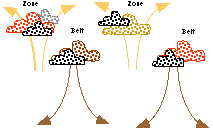This is a diagram showing the locations of the clouds of Jupiter.
Click on image for full size
Image from: Moons and Planets
Where to find Jupiter's Clouds
There are three different layer of clouds in Jupiter's atmosphere, as shown in this picture.
The clouds are made of complex molecules such as water. Another molecule which the Jupiter clouds are made of is ammonia, which smells!
Ammonia is what you use to clean the kitchen sink.
You might also be interested in:

You might think that clouds in the sky have to be made of water like those of Earth, but this is not always so. Clouds might be made of carbon dioxide or ammonia. Just take a peek at the planets Jupiter
...more
The troposphere of Jupiter is where the clouds are. Clouds form in regions of strong atmospheric motion, when condensation takes place. The troposphere is the region rapidly stirred by vertical motions.
...more
The giant planets have definitely changed since their formation. But how much remains to be seen. Most of the original air of the giant planets remains in place. (The earth-like planets lost most of their
...more
The mesosphere of Jupiter is a region of balance between warming and cooling. That essentially means that nothing happens there. Except for diffusion, the atmosphere is still. Upper reaches of the atmosphere,
...more
As on Earth, the atmosphere of Jupiter consists of a troposphere, stratosphere, mesosphere, and thermosphere. The troposphere is the region where the visible clouds are to be found. The stratosphere, as
...more
The stratosphere of Jupiter is a region of warming as determined by infrared measurements of methane (CH4) in the region. Like the troposphere, the stratosphere is warmed by the sun, warmed by Jupiter's
...more
On Jupiter, the winds in the belts and zones blow first in one direction, then in the opposite direction. Wind blows east in a belt, and west in a zone. The clouds rise up in a belt, and drop down in a
...more















